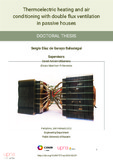Mostrar el registro sencillo del ítem
Thermoelectric heating and air conditioning with double flux ventilation in passive houses
| dc.contributor.advisor | Astrain Ulibarrena, David | es_ES |
| dc.contributor.advisor | Martínez Echeverri, Álvaro | es_ES |
| dc.creator | Díaz de Garayo, Sergio | es_ES |
| dc.date.accessioned | 2022-04-05T06:22:07Z | |
| dc.date.available | 2024-04-01T23:00:07Z | |
| dc.date.issued | 2022 | |
| dc.date.submitted | 2022-04-01 | |
| dc.identifier.uri | https://hdl.handle.net/2454/42629 | |
| dc.description.abstract | Esta tesis propone el uso de bombas de calor basadas en termoelectricidad, cuyas ventajas competitivas se basan fundamentalmente en la ausencia de partes móviles y de refrigerantes. Concretamente, esta tesis se centra en el diseño y construcción de un dispositivo de bomba de calor air-aire integrado con la ventilación de doble flujo en viviendas con una superficie inferior a 100 m2 y una envolvente de alta eficiencia energética tipo ‘Passive House’, donde la reducida carga de calefacción (<10 W/m2) permite climatizar el espacio con el caudal de aire de ventilación, aprovechando el calor residual del aire renovado. Los resultados demuestran que la termolectricidad puede resultar una alternativa real a la construcción de bombas de calor para la climatización de viviendas ‘Passive House’, dada la gran cantidad de ventajas (sistema silencioso, robusto, diseño ligero y fácilmente instalable en techos falsos, fácil regulación, integrabilidad con instalaciones fotovoltaicas y potencial de ahorro en los costes de fabricación), comparado con su menor eficiencia, fácilmente compensable con el incremento de la producción fotovoltaica integrada en el edificio. | es_ES |
| dc.description.abstract | This thesis proposes the use of heat pumps based on thermoelectricity, whose main advantages are related with the absence of moving parts and refrigerants. Specifically, this thesis focuses on the design and construction of an air-to-air heat pump device integrated with double flux ventilation in homes, with a surface area limited to 100 m2, and a highly energy efficient, as ‘Passive House’, where the reduced heating load (<10 W/m2) enables the possibility to provide enough heating by solely rising the temperature of the ventilation air flow, taking advantage of the residual heat from the renovated air. The results derived from this doctoral thesis show that thermoelectricity can be a real alternative to the construction of heat pumps for the air conditioning of ‘Passive House’ dwellings, given the big advantages (silent, robust system, lightweight design and easily installed on ceilings false, easy regulation, integrability with photovoltaic installations and potential savings in manufacturing costs) compared with its lower efficiency, that can be easily compensated with the increase of photovoltaic production integrated in the building. | en |
| dc.description.sponsorship | SMART CLIMA -1 project, funded by the Government of Navarre - PT050/2016, was the result of the collaboration of the CENER technology center, the Public University of Navarra and the company SIBER, specialized in ventilation solutions for the domestic sector; SMART CLIMA -2 project, funded by the Government of Navarre – PT009/2017. | en |
| dc.format.extent | 217 p. | |
| dc.format.mimetype | application/pdf | en |
| dc.language.iso | eng | en |
| dc.rights | © Todos los derechos reservados | es_ES |
| dc.subject | Termoelectricidad | es_ES |
| dc.subject | Bomba de calor | es_ES |
| dc.subject | Aire acondicionado | es_ES |
| dc.subject | nZEB | es_ES |
| dc.subject | Casa pasiva | es_ES |
| dc.subject | HVAC | es_ES |
| dc.subject | Optimización computacional | es_ES |
| dc.subject | Thermoelectricity | en |
| dc.subject | Heat pump | en |
| dc.subject | Air conditioning | en |
| dc.subject | nZEB | en |
| dc.subject | Passive house | en |
| dc.subject | HVAC | en |
| dc.subject | Air conditioning | en |
| dc.subject | Computational optimization | en |
| dc.title | Thermoelectric heating and air conditioning with double flux ventilation in passive houses | en |
| dc.title.alternative | Sistema termoeléctrico de calefacción y refrigeración con ventilación de doble flujo en casas pasivas | es_ES |
| dc.type | info:eu-repo/semantics/doctoralThesis | en |
| dc.type | Tesis doctoral / Doktoretza tesia | es |
| dc.contributor.department | Ingeniería | es_ES |
| dc.contributor.department | Ingeniaritza | eu |
| dc.rights.accessRights | info:eu-repo/semantics/openAccess | en |
| dc.rights.accessRights | Acceso abierto / Sarbide irekia | es |
| dc.embargo.terms | 2024-04-01 | |
| dc.identifier.doi | 10.48035/Tesis/2454/42629 | |
| dc.relation.publisherversion | https://doi.org/10.48035/Tesis/2454/42629 | |
| dc.contributor.funder | Universidad Pública de Navarra / Nafarroako Unibertsitate Publikoa | es |
| dc.contributor.funder | Gobierno de Navarra / Nafarroako Gobernua | es |
| dc.description.doctorateProgram | Programa de Doctorado en Tecnologías de las Comunicaciones, Bioingeniería y de las Energías Renovables (RD 99/2011) | es_ES |
| dc.description.doctorateProgram | Bioingeniaritzako eta Komunikazioen eta Energia Berriztagarrien Teknologietako Doktoretza Programa (ED 99/2011) | eu |


